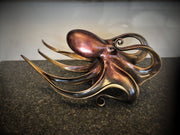About



Doug Wylie 1989 – Present, Artist and Designer.
Designer and creator of sculptures that primarily depict marine life – whales, dolphins, manta ray, octopus and more. Doug opportunities allowed him to submerged himself in Hawaiian waters with The Center For Whale Studies to better study his subjects. Based on careful and thoughtful interpretation of marine life and form, he creates original sculptured pieces in clay and transform it into a bronze masterpieces. He collaborates with various foundries and oversee the reproduction of his design into bronze statuary's which ranged from small table top statuettes to monumental publicly display statues.
DOUG WYLIE BIOGRAPHY
Education California State University, Sacramento, BA 1976, Fine Arts/Ceramics
and Credential Education Program
Pacific Whale Institute, Maui Hawaii, 1991-1993, volunteer to participate in the study of Humpback Whales.
Artist 1978 to present. Ceramic, Pewter and Bronze. Primary expertise is creating sculptured work of art in clay and then collaborate with a foundry for reinterpretation and construction into pewter and/or bronze sculpture. Final bronze sculpture work is on a varying scale from small intimate statuettes to very large monuments that are erected for outdoor public viewing. Adept at creating hand-built and wheel turned ceramic ware. Primary subject matter is marine life, birds, animals. Technique ranges from accurate representation to a stylized/motion influenced interpretation.
ClayFish Ceramics 1979-1989. Designer, Artist and Business Owner. Designed and created and extensive line of marine life/”whale tail” ceramic ware for production and resale. Personally designed and created all original ceramic pieces, selected glazing and finishing, and produced the final original prototype. Additionally, facilitated the mass production of the ceramic including construction of the plaster molds for high volume production and then overseeing final production of items for resale. Supervised and coordinated production staff to facilitate reproduction, handling and shipping of items.
Wylie Sculpture 1989 – 2012. Artist and Designer. Designed and created sculpture pieces that primarily depicted marine life – whales, dolphins, manta ray, octopus and more. Based on careful and thoughtful interpretation of marine life and form, created original sculpture pieces in clay and then collaborated with various foundries to oversee the reproduction of the piece into bronze statuary which ranged from small table top statuettes to monumental publicly displayed statues.
Designer Wylie Design 2005 – present. Designer, Artist, Entrepreneur. Revival of customized ceramic ware and sculpture, increasing the variety of subject matter and incorporating new styles and methods.
How to Care for your Bronze Sculpture
Patina
Patina refers to the colors of the surface of a bronze. The sculptor creates this color by applying chemicals on the sculpture with heat.
Patina is also the natural reaction of bronze to atmospheric conditions, such as chemicals and humidity. To deter change in the patina, the Doug Wylie Design artist or the foundry will protect the patina with coats of wax or a laquer.
Because atmospheric elements constantly work on bronze surfaces after leaving the foundry, certain steps, outlined below, can be taken by the owner to preserve the original patina.
Care and Cleaning
The first caution is to display your bronze sculpture in a location that will best preserve it. Bronzes should be displayed in ventilated areas away from excessive heat and humidity. Attics and basements should be avoided.
Keep your sculpture clean by dusting it with a soft cloth or very, soft shoe brush. If de-greasing or heavier cleaning is required, test a small area first, cleaning it with a mild soap and distilled water. Rinse thoroughly and allow to dry thoroughly.
Waxing
Instead of using waxes or polishes that may contain cleaning agents, foundries recommend Johnson’s Paste Wax, which is inert and will not yellow over time. A very thin, even coat of wax should be applied with a soft rag and buffed with a clean soft rag.
Highly humid areas may call for more frequent applications. Allow the wax to sit and dry from six to twelve hours before polishing. A second coat of wax will add additional gloss if desired. There is no harm in waxing a sculpture more frequently. Bronze is an extremely hardy, durable metal, lasting for centuries! The patina is the most delicate part of your bronze. Contact a reputable gallery, foundry or professional conservator concerning significant changes to your bronze’s patina. In the meantime, enjoy your bronze as a beautiful work of art.
Care of the High Polish area of your Sculpture
Use a clean, very SOFT dry cloth. Carefully apply Mothers Mag & Aluminum Polish or Brasso to the high polish area, and remove according to the direction on the product. (These product s are available at most hardware supply stores or online). Be very careful not to get these products on the patina as this could damage the fine line between the high polish and the patina.
Cleaning and Care Cautions If, in the cleaning process you find special coatings or unusual varied patinas, take care to not alter the surface or remove coloring that could damage the future value of the bronze sculpture. Don’t use abrasive polishes, brushes or chemicals which could scratch the metal surface.
Some bronze owners prefer to let the wax coating wear thin and enjoy the natural reaction and aging process of the patina.
You’re Ready!
You now have the knowledge that you need to clean and care for your bronze sculpture so you can enjoy it for years to come. Enjoy!
If your sculpture requires additional care - Contact us at: dougwyliedesign@gmail.com
